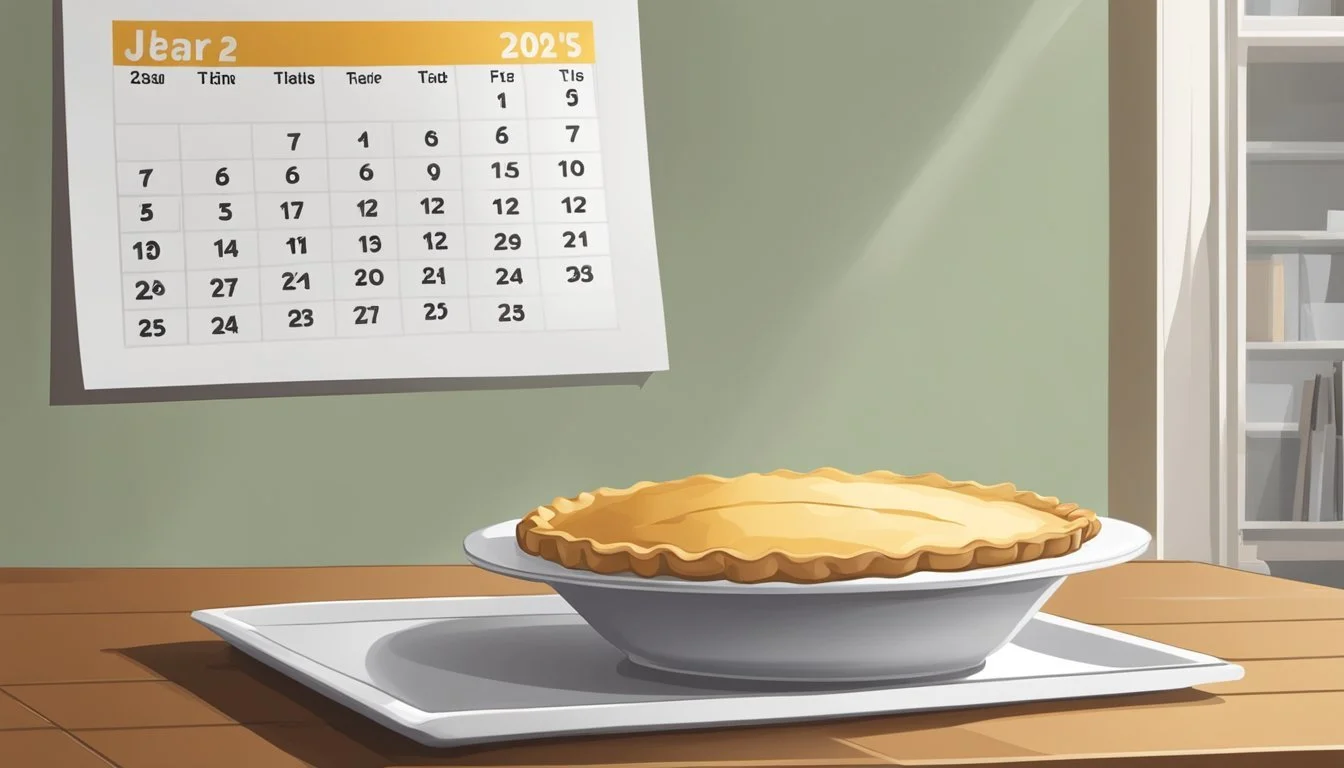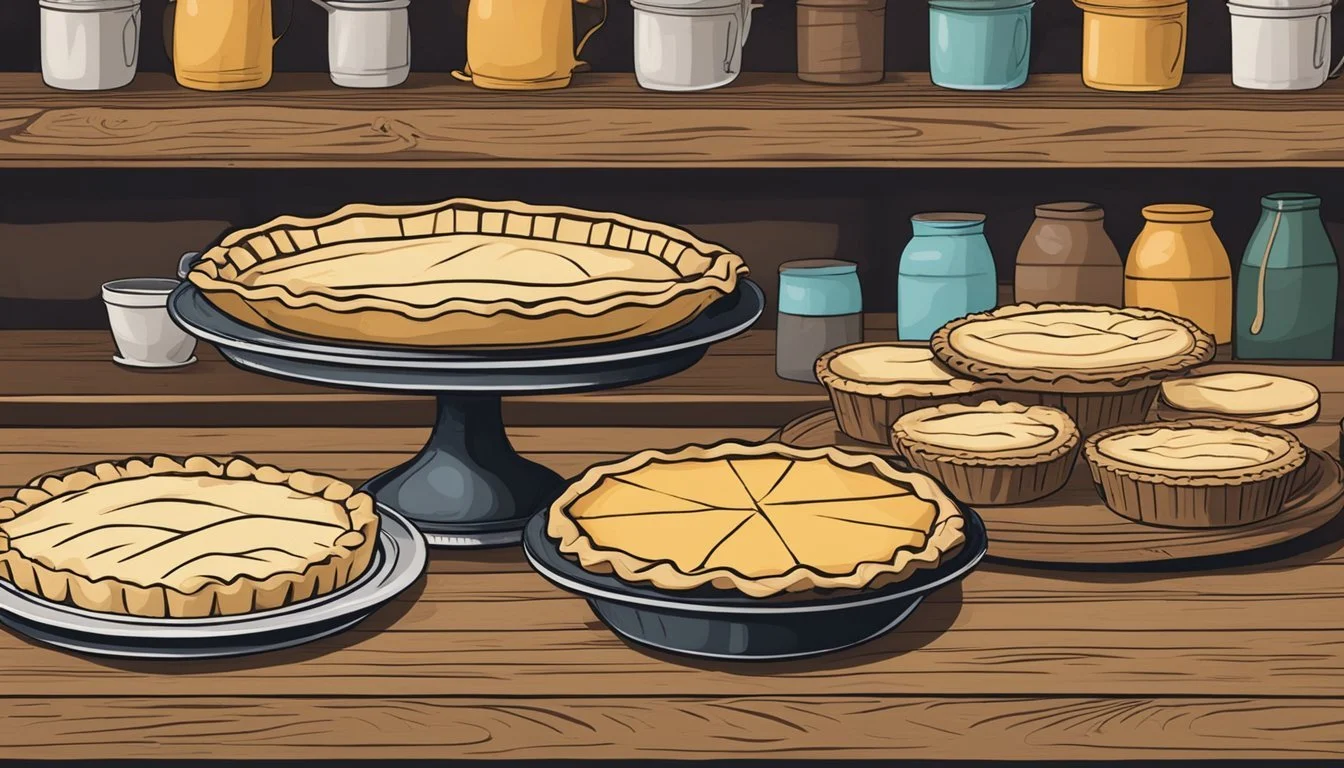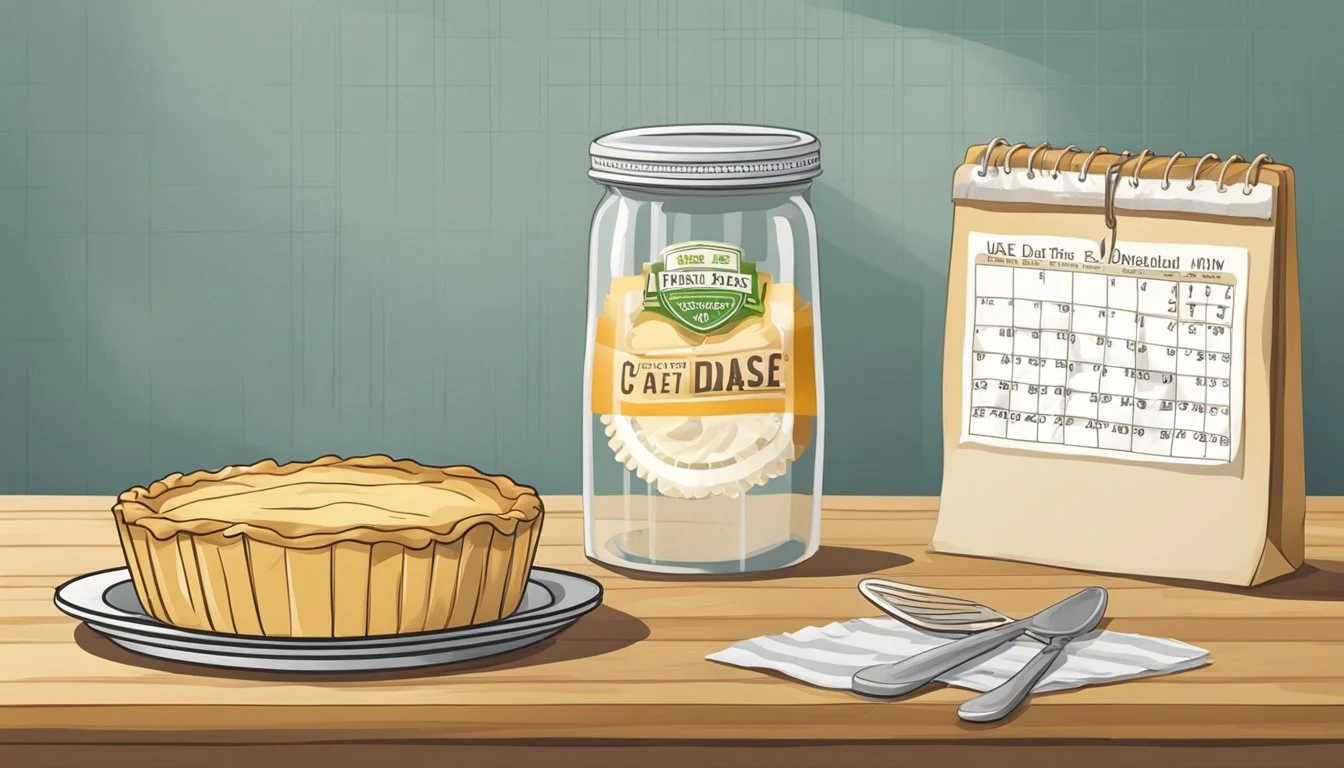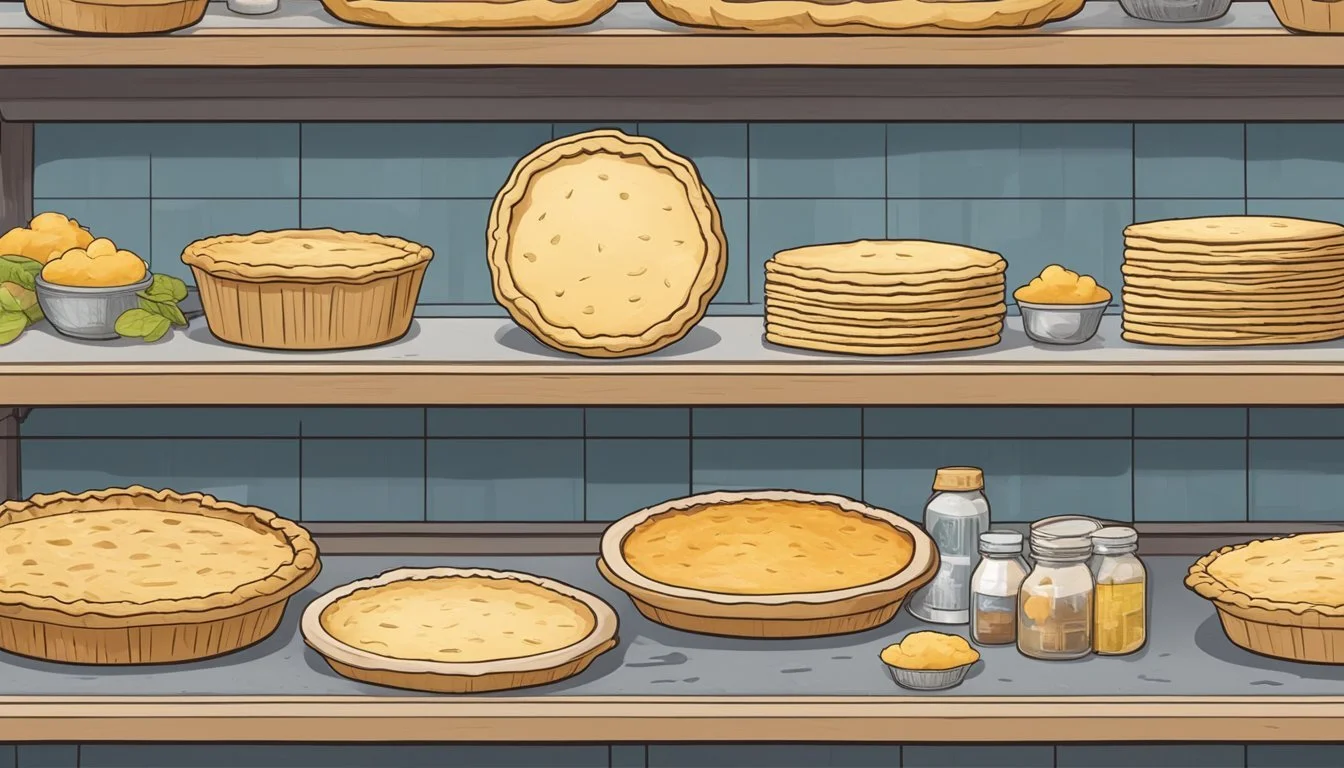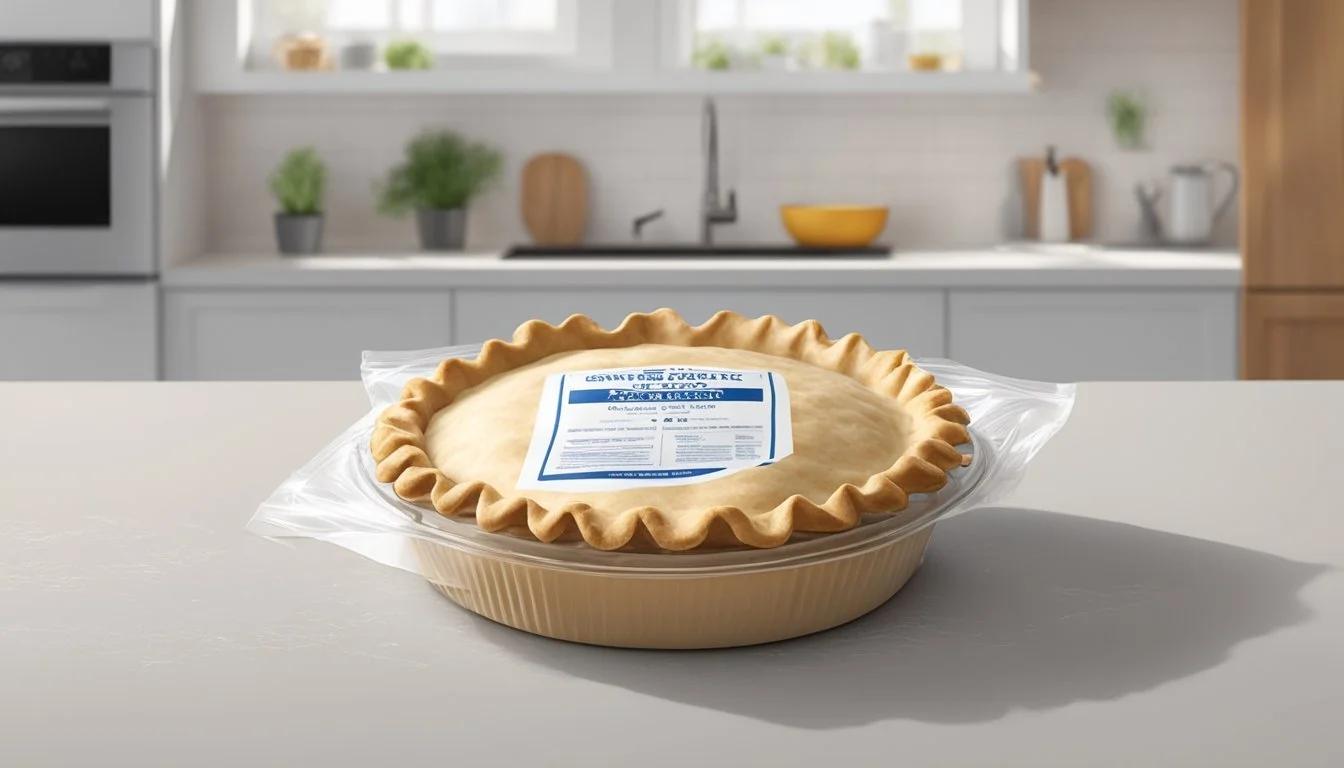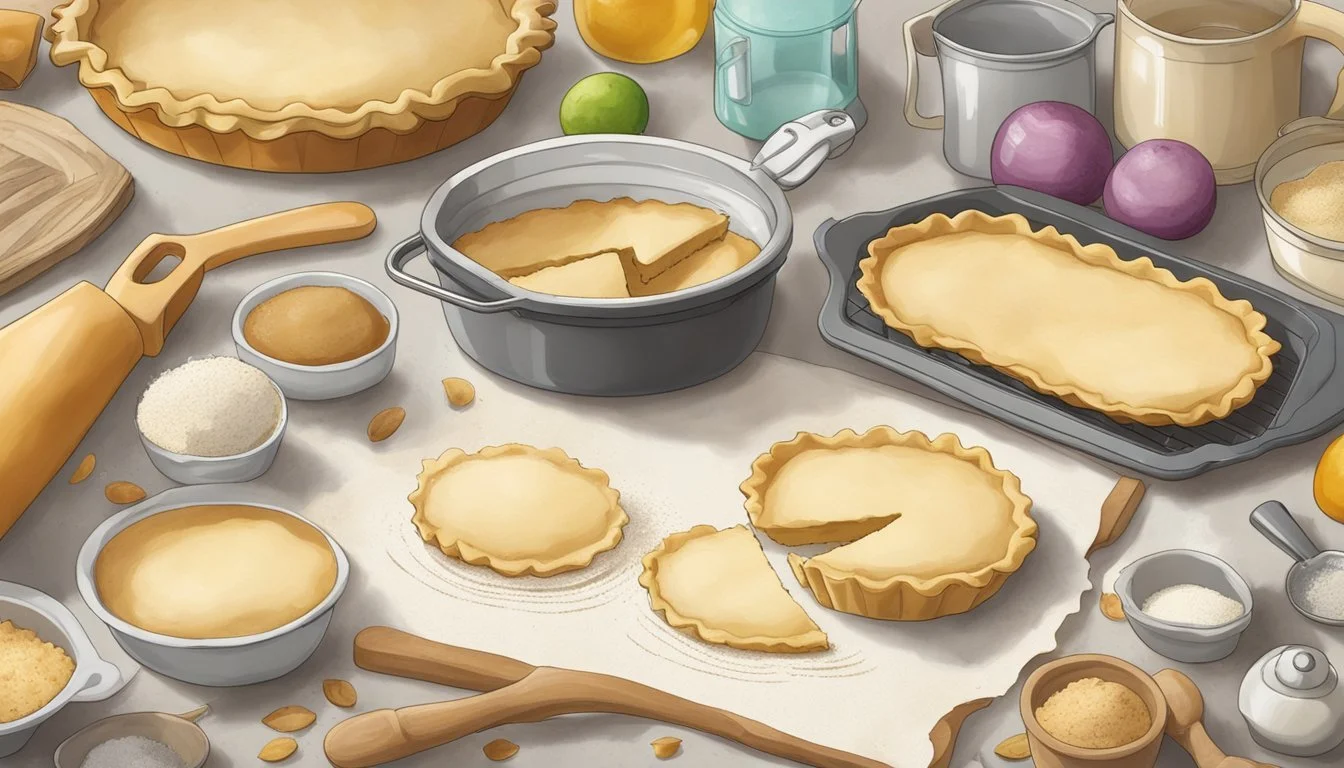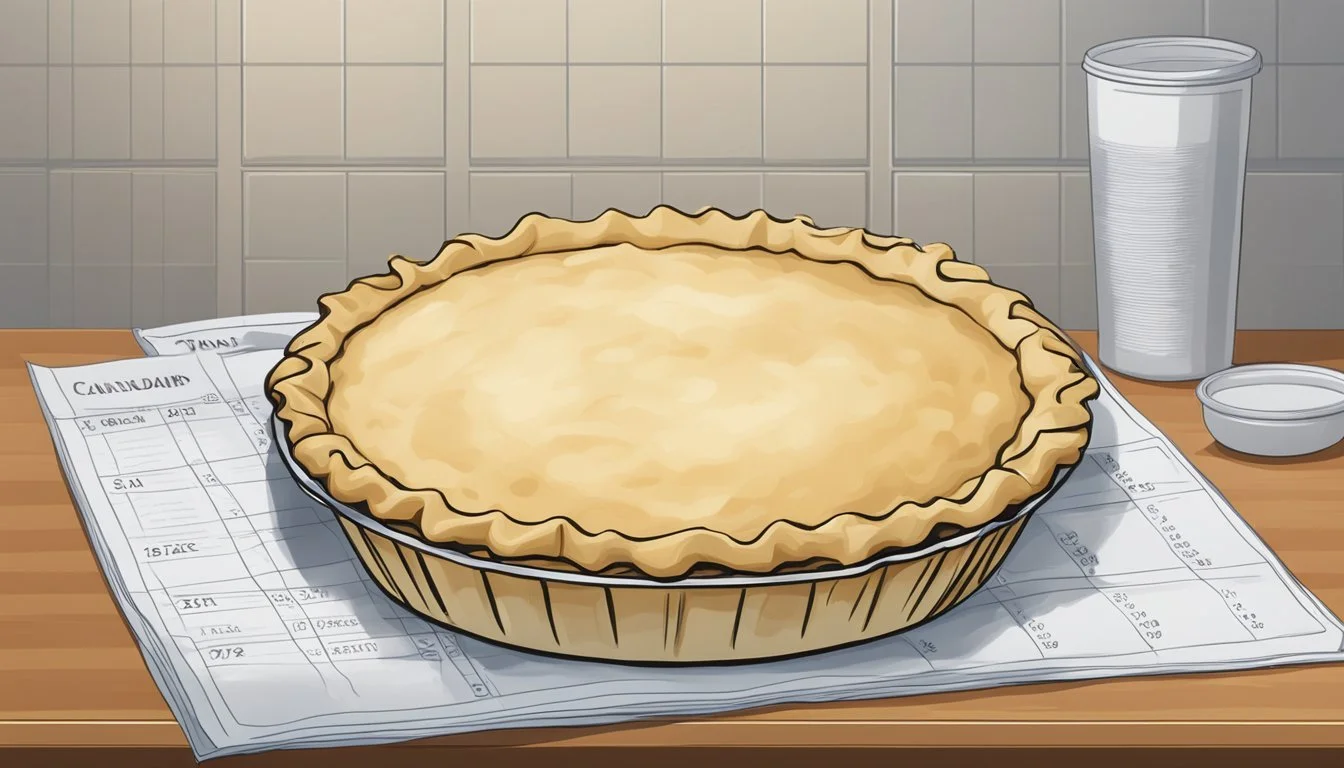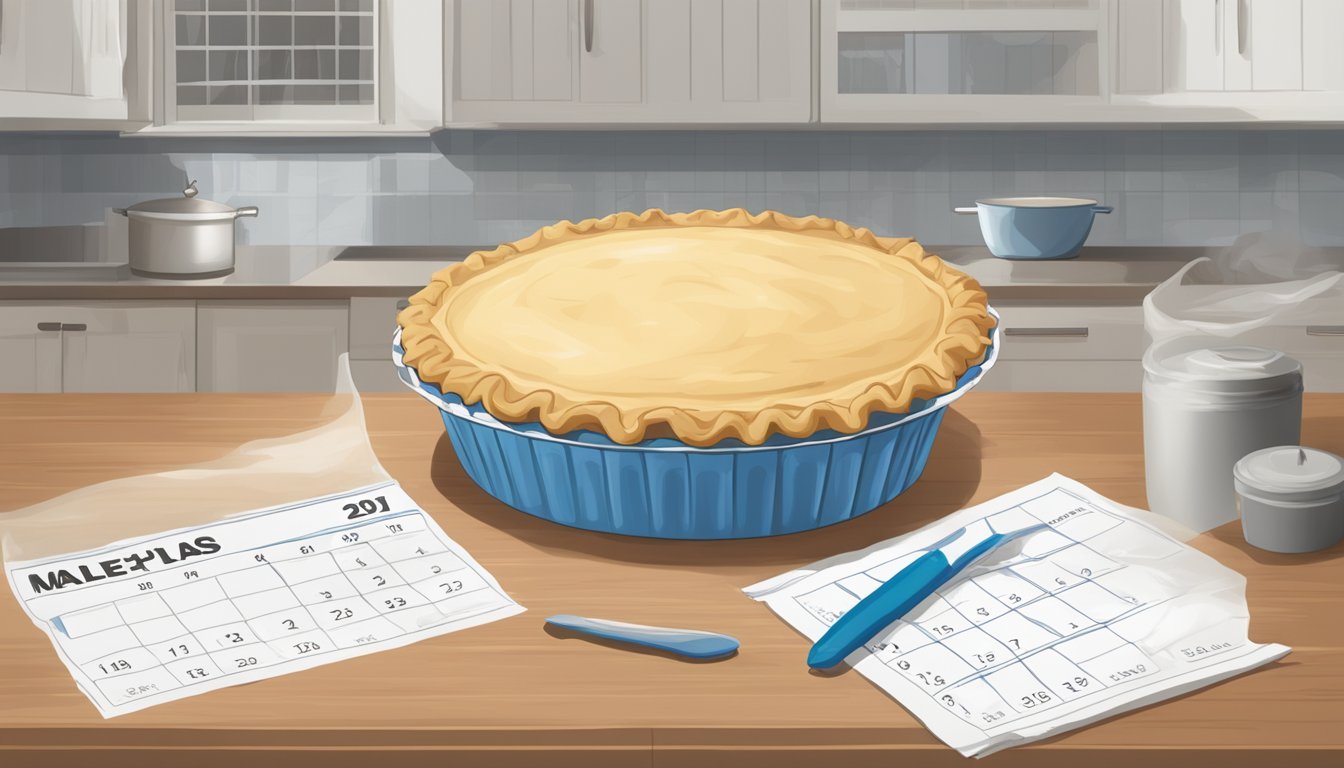How Long Does Pie Crust Last?
Shelf Life and Storage Tips
When it comes to baking, the longevity of a pie crust is an essential consideration for both amateur and professional chefs. The shelf life of a pie crust, whether homemade or store-bought, can affect the quality and safety of the finished pie. Understanding how to properly store pie crust is key to maintaining its freshness and ensuring that it remains a delectable base for your filling of choice.
Homemade pie crusts are typically made from a blend of flour, fat, salt, and water. They can last in the refrigerator for approximately 2 to 5 days if stored correctly. Wrapping the crust tightly in plastic wrap or aluminum foil can markedly extend its freshness by preventing it from drying out or absorbing unwanted odors. Similarly, store-bought pie crusts have a comparable refrigerated shelf life and should also be well-wrapped for optimal preservation.
For either type of pie crust, the storage environment matters. Keeping the crust in an airtight container in the refrigerator minimizes exposure to air and moisture, two factors that can lead to staleness or the growth of harmful bacteria. With proper storage methods, one can harness the full potential of their pie crust, maintaining its quality until it's ready to be baked into a delightful treat.
Types of Pie Crust
The variety of pie crusts available, such as homemade, store-bought, frozen, and refrigerated, each comes with its own set of characteristics, affecting both texture and shelf life.
Homemade vs. Store-Bought Pie Crust
Homemade pie crust generally calls for a few basic ingredients: flour, fat, salt, and water. The ratios and the handling of these ingredients can lead to either flaky or tender crusts suitable for various types of pies, from fruit pies like apple and pumpkin to custard-based pies. Store-bought pie crusts offer convenience and consistency in texture and performance. They are available in a frozen state or refrigerated and can be used for making tarts, quiches, (What wine goes well with quiche?) or traditional pies without the extra work involved in making a crust from scratch.
Differences Between Frozen, Refrigerated, and Dry Pie Crusts
Frozen pie crusts are ready to be filled and baked, they can be kept frozen until use, and work well for both sweet and savory recipes. The longevity of a frozen crust exceeds that of the refrigerator variety, often lasting months when correctly stored.
Refrigerated pie crusts come in a pliable form that is ideal for quick preparations. They are best when used within a few weeks of purchase for pies that require a flaky, buttery crust, such as pecan pie or tarts.
In contrast, dry pie crusts, such as graham cracker or shortbread crusts, are often used for chilled pies. They are typically mixed with butter and pressed into a pan, then baked or chilled to set. They should be consumed relatively soon after preparation for optimal taste and texture.
Proper Storage Practices
For pie crusts to maintain their quality, they need to be stored with care. Proper wrapping and temperature control are vital to extend shelf life and preserve the texture and taste.
The Essentials of Wrapping and Packaging
When one stores a pie crust, it should be tightly wrapped in plastic wrap or aluminum foil to prevent moisture loss and protect from air, which could lead to freezer burn if stored for extended periods. For additional protection, one can place the wrapped crust in an airtight container or a plastic bag. This helps to shield the crust from absorbing odors from other foods, especially relevant in a refrigerator setting. Here is a simple guide on how to wrap pie crust:
Lay out a sheet of plastic wrap or aluminum foil.
Place the pie crust or dough onto the center of the wrap.
Fold the edges of the wrap over the crust, pressing out as much air as possible.
If using a container or bag, place the wrapped crust inside and seal securely.
Optimal Temperature for Storage
Temperature is a critical factor for storing pie crusts. The refrigerator is ideal for short-term storage, where homemade or store-bought pie crust can last for 5 to 7 days. The refrigerator's constant temperature keeps the crust fresh, while the consistent environment ensures the texture remains as intended.
For longer storage, a freezer is the best option. In a freezer, the pie crust should be kept at 0°F (-18°C) or lower to ensure that it remains safe to eat for an extended period. When needed, the crust can be thawed in the refrigerator before use. Here are optimal storage temperatures at a glance:
Location Temperature Range Storage Duration Refrigerator 32°F to 40°F (0°C to 4°C) Up to 1 week Freezer 0°F (-18°C) or below Several months
Shelf Life and Spoilage Indicators
When considering the longevity of pie crusts, one should be aware of their shelf life and the signs of spoilage. This knowledge ensures the quality and safety of the crusts used in baking.
Signs of a Pie Crust Gone Bad
Mold: Visible mold growth, usually appearing as fuzzy spots of various colors, is a definite indicator that a pie crust has gone bad. Off Smell: A sour or unpleasant odor emanating from the crust signifies spoilage. Discoloration: Any unusual changes in color can suggest that the crust is no longer fresh. Texture: A pie crust that has become overly hard, or conversely, soggy, indicates that it is past its prime. Quality: The presence of an off flavor or change in flavor profile is a clear sign that a pie crust should not be consumed.
Understanding Expiration Dates
Shelf Life: Commercially-prepared pie crusts have a shelf life that ranges from a few weeks to a few months. Homemade pie crusts typically last 3-5 days in the refrigerator.
Expiration Date: Always check the expiration date on store-bought pie crusts; this is a reliable guide for determining the freshness before use. After the expiration date, quality and safety may be compromised.
Properly Stored: The lifespan of a crust is directly related to how it is stored. A tightly wrapped crust, whether homemade or store-bought, can last for about 5 to 7 days in the refrigerator. In the freezer, a crust can maintain its quality for up to two months.
The reader is equipped with the necessary markers of spoilage and can interpret expiration dates to make healthy decisions around the use of pie crusts.
Freezing and Thawing Pie Crust
Proper freezing and thawing techniques are essential for maintaining the quality and extending the shelf life of pie crusts. Whether the crust is baked or unbaked, these processes help to prevent freezer burn and ensure a pie crust that's ready for baking.
How to Freeze Pie Crust
Unbaked Pie Crust: To freeze an unbaked pie crust, one should first shape it into a disk or into the intended pie plate. For disks, wrap them in plastic wrap and place them into a freezer bag, removing as much air as possible. If freezing in a pie plate, one can cover it tightly with plastic wrap or aluminum foil.
Labeling: Always label the freezer bag or the foil with the date and type of crust.
Baked Pie Crust: Baked pie crust needs to cool completely at room temperature before freezing. Once cooled, wrap the crust well in plastic wrap and follow it with a layer of aluminum foil.
Prevention of Freezer Burn: Double wrapping is crucial to prevent freezer burn and to preserve flavor and texture.
Thawing Tips for a Ready-to-Use Crust
Refrigerator Thawing: For both baked and unbaked pie crusts, the safest method is to thaw them overnight in the refrigerator.
Time Management: Planning is key, as a gradual thaw maintains the crust's integrity.
Room Temperature Thawing: If time does not permit refrigerator thawing, one can thaw an unbaked pie crust on the counter for about an hour. Baked pie crusts, however, are more fragile and should remain in the refrigerator to thaw.
Direct Baking: It's often possible to bake an unbaked, frozen pie crust without thawing. This requires an adjustment in the baking time and is ideal for long-term storage needs.
By strictly following these freezing and thawing recommendations, one can ensure a pie crust that is as good as fresh, anytime baking inspiration strikes.
Baking with Pie Crust
The integrity of a pie crust is paramount in baking, with the pre-baking process setting the foundation for texture and the careful balance of ingredients contributing to the final taste and structure.
Pre-Baking Pie Crust
Before filling a pie crust with moist ingredients, pre-baking (also known as blind baking) is essential for preventing a soggy bottom. To pre-bake a pie crust, one should follow these steps:
Preheat the oven to 375°F (190°C).
Line the pie dough with parchment paper and fill it with pie weights or dried beans to keep the dough from puffing up.
Bake for about 20 minutes, then remove the weights and parchment and bake for another 15-20 minutes until it’s golden brown.
Pre-baking solidifies the fat within the dough, creating a barrier that helps maintain the crust's shape and provides a crisp texture once the filling is added.
Making the Perfect Pie Crust
Achieving the perfect pie crust starts with the precise balance of ingredients and method:
Fat content: A combination of butter for flavor and shortening for flakiness is often used. The fat should be well-chilled to ensure a flaky texture.
Flour: Provides the structure. All-purpose flour is commonly used.
Sugar: A small amount can add flavor and aid in browning.
Salt: Enhances the overall flavor of the crust.
Dairy: Milk or water is added to bind the dough. The amount of liquid will affect the dough’s moisture level and final texture.
Eggs: Sometimes used to enrich the dough and affect the texture.
To make pie crust:
Whisk together flour, sugar, and salt.
Cut in chilled fat until mixture resembles coarse crumbs.
Gently add just enough cold water or milk to bring the dough together.
Form into a disk, wrap, and refrigerate before rolling out.
The keys to a homemade pie crust that’s both tender and flaky are the right ratio of ingredients and minimal handling of the dough to keep the fat from melting before baking.
Safety and Health Considerations
Ensuring the safety and health of consumers is paramount when it comes to the shelf life and storage of pie crusts. It's crucial to handle and store pie crusts properly to maintain their quality and to prevent the growth of harmful bacteria.
Avoiding Contamination and Bacterial Growth
Storage Technique: Pie crusts should be stored tightly sealed in their packaging or wrapped in plastic wrap or aluminum foil to prevent them from absorbing odors and flavors from other foods. In the refrigerator, this also helps to maintain a proper temperature and humidity level which are critical factors in preventing bacterial growth.
Freshness and Quality: A crust's freshness impacts not just its flavor but also its safety. Ingredients like fat, sugar, and spices can affect how quickly a crust becomes unsafe to consume. A freshly made dough, especially one with dairy or eggs, is more prone to the growth of harmful bacteria if not stored correctly.
Refrigeration: Maintaining a consistent refrigerator temperature below 40°F (4°C) is vital to limiting bacterial growth. After opening or using a pie crust, returning it promptly to this cooled environment is important for safety.
Bacteria: The presence of harmful bacteria such as Salmonella or E. coli is a risk when pie crusts are left at room temperature for too long, especially those with high-risk ingredients like eggs or milk.
Calories and Nutrients: While not directly linked to safety, the nutritional content of pie crusts, such as calories, can be affected by storage conditions, potentially leading to degradation in quality over time.
Handling Filling and Dough: When adding filling to a pie crust, ensure that both components are handled safely. Cross-contamination can occur if the fillings or utensils used are not clean.
Pie Plate Preparation: It's essential for a pie plate to be clean, as bacteria can reside in crevices or on surfaces if not properly washed.
Preventing a Soggy Crust: To avoid a soggy crust, pie crusts should be baked until they are completely done, as a moist environment is conducive to bacterial proliferation.
Remember that while a pie crust may appear safe to use, the absence of a spoiled odor or appearance does not ensure its safety. Regularly check stored crusts for signs of spoilage and adhere to recommended storage durations for best quality and safety.
Creative Uses for Pie Crust
Pie crusts have ventured far beyond their customary role in sweet dessert pies. They serve as a versatile base, imbued with potential to transform into a variety of delectable dishes, both sweet and savory.
Beyond Traditional Pies
The versatility of pie crust extends to a range of sweet alternatives. Tarts and pastry creations allow bakers to showcase the flaky, buttery qualities of the crust, transitioning ordinary desserts (What wine goes well with desserts?) into gourmet presentations. An individual can craft fruit pies that differ from the classic apple pie — think mixed berry or stone fruit delicacies. Another route for pie crust innovation is incorporating it into custard-based desserts, where the crust adds a textural contrast to the smooth filling.
Mini Pies: Using pie crust to make bite-sized versions of traditional favorites.
Tarts: Crafting a fruit tart, such as a raspberry or lemon tart, for a refreshing change.
Savory Dishes and Innovations
When one steps into the kitchen to utilize pie crust for savory dishes, they open a doorway to robust flavors and inventive meals. Pie crust acts as an excellent base for quiches and meat pies, absorbing and complementing the hearty fillings. For those looking to make their own personalized dish, they can fill pie crusts with a fusion of cheeses, vegetables, or various meats to create unique savory dishes. Think of turning a simple pie crust into a sophisticated spinach and feta quiche or a rich, savory beef and onion pie.
Quiches: Assembling a quiche with seasonal vegetables or gourmet cheeses offers a refined meal option.
Pot Pies: Transforming pie crust into a comforting chicken pot pie (What wine goes well with chicken pot pie?) with a creamy filling and a crisp crust.
Using pie crusts in these innovative manners allows for endless culinary creativity, where the only limit is one's imagination and the boundaries of their palate.
Pie Crust in the Culinary World
In the world of baking, pie crust is a fundamental element that impacts flavor, texture, and freshness of pies. It serves as a versatile base that can be altered to fit different culinary traditions.
Comparisons to International Pastry Traditions
Internationally, pastry crusts are a universal concept, but each culture has its unique take on this essential baking component. The European tradition, rich in buttery layers, presents variants such as the French pâte brisée, which is similar to the American pie crust but often richer and flakier due to higher butter content. In contrast, countries like Greece or Turkey utilize filo dough, a paper-thin pastry that creates a drastically different texture, often used in dishes like baklava.
King Arthur, an authoritative figure in the world of baking, suggests that a well-executed pie crust should balance tenderness with structural integrity, avoiding outcomes like soggy crust or a crust that is drying out. In comparison to American pie crust, Italian pasta frolla is typically sweeter and used for tarts or cookies, showing the adaptability of pastry to regional tastes and textures.
In terms of preserving freshness and texture, how a pie crust is handled and stored plays a crucial role. Pie crusts should be kept tightly wrapped to prevent them from drying out, and stored with care to maintain the desired flavor and freshness. This attention to detail reflects an understanding of the pie crust's central role in the dessert's final quality, as seen across international culinary traditions.
Tips and Tricks
In exploring the fine craft of pie crust perfection, the baker must consider both the enhancement of flavors and textures and the strategies for extending the life of their dough.
Enhancing Flavors and Textures
To craft a pie crust that boasts superior flavor and texture, it’s crucial that bakers select the appropriate fat content, which greatly influences flakiness. Butter imparts a rich taste, while shortening or lard provides a more tender texture. An expertly made crust often employs a combination of fats. For instance, King Arthur Flour suggests using both butter for flavor and shortening for tenderness.
Fat content:
Butter: Adds a rich flavor.
Shortening/Lard: Ensures a flaky, tender texture.
Integrating spices into the dough can greatly elevate the crust's taste. Common additions include:
Spices:
Cinnamon: Complements sweet fillings.
Nutmeg: Offers a warm, nutty flavor.
Longevity and Reuse of Pie Crust
Freshness plays a pivotal role in the pie-making process, yet bakers often need to manage time effectively by preparing dough in advance. Properly storing pie crust is essential for maintaining its freshness and usability. For short-term storage, wrap the dough tightly in plastic and keep it in the refrigerator for up to three days. For long-term storage, a baker should wrap the crust in both plastic and foil, label with the date, and freeze it; this method can preserve the dough for up to three months.
Short-term storage: Refrigerator (up to 3 days)
Long-term storage: Freezer (up to 3 months)
Before reusing a frozen crust, one must thaw it in the refrigerator overnight to ensure even baking and to maintain the desired texture. When ready to bake, bringing the dough to slightly cooler than room temperature ensures it retains its shape when rolled out and placed in the pie dish.
Conclusion
When considering the shelf life of pie crust, whether homemade or store-bought, maintaining quality and flavor hinges on how it is properly stored. For homemade pie crust, it can typically last 5 to 7 days in the refrigerator when properly wrapped in plastic wrap or aluminum foil, and placed in an airtight container.
In contrast, baked pies have a shorter shelf life at room temperature, lasting about 2-3 days before there's a risk of spoilage. To prolong this time, storage in the refrigerator is advisable.
Store-bought pie crusts come with a use-by date, but they can usually remain in good condition for an additional 2-4 weeks past this date if refrigerated and sealed correctly.
Here’s a quick reference to summarize:
Homemade pie crust (refrigerated): 5-7 days
Baked pie crust (at room temperature): 2-3 days
Store-bought pie crust (past expiration, refrigerated): 2-4 weeks
Ultimate freshness relies on a tight seal to keep moisture out and prevent absorbing other odors. Any crust containing milk-based ingredients may spoil faster than other types. It is crucial to monitor the crust's condition, looking for any signs of off-odors or discoloration as indicators of spoilage.
By adhering to these guidelines, individuals can ensure their pie crusts maintain their best quality in terms of taste and texture.
Remember, the life span of pie crust can be influenced by factors such as ingredient composition, proper wrapping, and consistent refrigeration.

